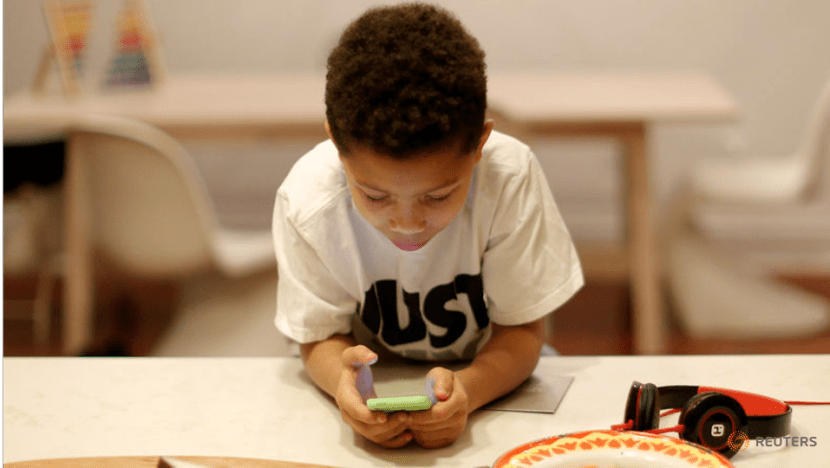commentary Commentary
Commentary: The case for universal digital access, as home-based computing becomes a post-pandemic norm
In an increasingly digital world where more will work and learn from home, reliable technology and Internet access are needs not wants, say professors Irene YH Ng and Lim Sun Sun.

Photo illustration of a child using a laptop computer (Photo: Jeremy Long)
SINGAPORE: Can you imagine your HDB flat not wired for electricity, or piped with water? Doubtless, you find that notion unthinkable.
Flats are meant to come with water and electricity after all, and we have long taken that provision for granted.
Now imagine the moment we move into our flats, we can immediately log onto Wi-Fi Internet access because every apartment comes with a router. Should this latter scenario be that inconceivable?
Sixty years ago, before Singapore’s comprehensive industrialisation, electricity and filtered water were not a given in households. Only the wealthy could afford these luxuries in their homes.
Today, they are regarded as public utilities. With the United Nations’ declaration in 2011 of Internet access as a human right, is it not time to make Internet access a public utility that everyone can access as we do water and electricity?
This question is one that bears asking after our tumultuous experience with COVID-19. With the two-month long circuit breaker sequestering everyone at home, families have had to develop creative strategies to blend work-from-home arrangements with home-based learning needs.
READ: Goodbye office: Is the future of work in our homes?
READ: Commentary: Do you really want to work from home forever like some Twitter employees can?
TECHNOLOGY INEQUALITY
Yet, this new norm has also amplified a technology gap that must be closed because ultimately, online inequalities have offline consequences.
As local media reports revealed, the home-based learning experience was highly uneven across families.
Whereas affluent families fretted over higher order concerns such as the quality of online instruction and children’s excessive screen time, less well-off families grappled with basic problems of device ownership and Internet access.
There was a rapid response to this immediate digital access challenge. Minister in the Prime Minister’s Office and Second Minister for Education Indranee Rajah estimated that the Ministry of Education has loaned out more than 20,000 computing devices and more than 1,000 Internet access devices during this circuit breaker period.

In addition, social service agencies rushed to help their clients apply for subsidised computers and Internet connection through the NEU PC Plus scheme, and solicit additional digital resources through donations.
But the longer-term issue we must now address is what will happen after the pandemic is over? Will students have to return the loaned devices, or can we now conceive of a world where digital access becomes a universal necessity provided as a public good?
HOME-BASED COMPUTING SET TO BECOME POST-PANDEMIC NORM
The imperative to make digital access universal is a compelling one.
According to Professor Jean Yeung’s recent Straits Times article on her study of a nationally representative sample of over 5,000 children aged six and under, although the Wi-Fi penetration rate is near universal in Singapore, 8 per cent of families in her study who lived in rental units did not have a connection, and 44 per cent lacked a computer or a laptop at home.
Most learning platforms are optimised for computers and even though mobile devices do offer connectivity, their utility for educational purposes is limited. Yet, greater home-based technology usage for teaching and learning is set to become a new post-pandemic norm.
READ: Commentary: Don’t expect your kids to return to school seamlessly
READ: Commentary: It is time to rethink how we do online education
Beyond learning for children, home-based computing will also be essential if low-income adults are to have any real chance to participate in more technology-based training or employment.
The progress of our Smart Nation drive has also translated into a greater range of government services moving online, thus making digital access even more of a need than a want.
Digital inclusion is therefore critical to prevent a growing chasm between high and low-income families, one that will further widen in a world where economic and social inequalities are already gaping.
UNIVERSAL INTERNET CONNECTION
Shifting to a paradigm of universal digital access entails making Internet connection and computing devices more universally available.
Universal Internet connection might be more easily achievable. Singapore’s Wireless@SG programme already provides free Internet access across broad swathes of public space.

With our Nationwide Broadband Network successfully in place, offering broadband access speeds of 1Gbps and more, extending free home Wi-Fi to residential areas will not involve more than a concerted coordination with telcos outfitting every home with modems and wireless routers.
Felicitously, our transition towards 5G provides a strategic opportunity to “reset” our digital infrastructure networks for universal Internet access.
READ: Commentary: Huge investments and 5G super highways. How China is powering ahead in the network race
READ: Commentary: Alibaba makes a whopping US$28 billion bet on its next breakthrough act
COVERAGE FOR DIGITAL DEVICES FALL SHORT
Universal access to computing devices, though, might be more of a leap.
The current NEU PC Plus scheme offered by IMDA is generous and well-intentioned.
Yet, as with all mean-tested programmes with conditions, coverage will fall short. Some who need it will not apply while some who apply will not be given.
This was seen in the sudden flurry to apply for NEU PC Plus after the circuit breaker was announced. Even though this scheme has been in place since 2006, many low-income families still did not have digital resources when home-based learning was suddenly activated.
It might be that low-income families did not apply because of lack of knowledge. Some did not know about the programme, while others found the application form too complicated.
Another probable cause is that in less affluent homes, computers are less of a priority than mobile phones. As Prof Lim Sun Sun discovered from her research on low-income families’ technology use, mobile-first or mobile-only households find their communication and entertainment needs well met by mobile phones. They de-prioritise computers due to their higher costs.

Other families might not qualify because they already own devices. For example, households might already have a computer but these are often old, slow and poorly maintained.
One computer might also be shared among all household members, thereby leading to stiff competition for scarce resources if multiple children are engaging in home-based learning.
UNIVERSAL ACCESS TO COMPUTING DEVICES
How might a more universal approach safeguard against the above unmet computing needs? Universal provision assumes need with less concern over deservingness.
Thus, greater universalism could materialise in the form of automatic allocation, as is the case now with Baby Bonus, Workfare Income Supplement (WIS), and Silver Support.
Possible channels include building computing provision as part of school registration, ComCare benefits, or WIS. Stepped levels of subsidies according to household income and number of household members could also be introduced, similar to the subsidy ladders for childcare and baby bonus.
READ: Commentary: The trouble with helping disadvantaged kids is you don’t know where to start
READ: Commentary: Cash assistance is often shunned but enhances the safety net for low-income families
In terms of funding, technology companies should be mobilised to co-fund such provisions as a cornerstone of their corporate social responsibility efforts.
We can also reconsider the extent to which we need other public goods and services.
For example, landscaping and cleaning costs could be reduced by decreasing the frequency of grass-cutting and road sweeping, and the number of rubbish bins in public spaces.
ACCELERATING DIGITAL LITERACY PROGRAMMES
In this fast technologising world, we must take the bold but urgent step towards recognising basic computing as a state-supported public utility. Households would then be encouraged to assign greater priority to computers over mobile devices.
Once the basic computing infrastructure is in place, subsequent units of computers or laptops also become more affordable.
MOE’s national digital literacy programme announced in Parliament this year envisions that every secondary school student will have a personal digital device by 2028. Efforts should be made to accelerate this scheme so that all our students are sufficiently supported to access home-based learning.

In tandem, digital literacy efforts must also be boosted. Invariably, better educated parents will be more tech-savvy and can therefore offer more effective guidance of their children’s digital access.
Hitherto, some donors have been reluctant to provide Internet access to needy families, citing fears that they will be vulnerable to online risks such as pornography or online gambling.
Indeed, we need more intensive in-school digital literacy programmes to help these children make up for the lack of scaffolding at home.
However, poor digital literacy should not be used as justification to deny low-income families access to a vital resource that the rest of society benefits from.
READ: Commentary: Three literacies to level up Singapore’s disruption game
READ: Commentary: Why lifting lockdowns and easing restrictions will be harder for some countries
LEAVING NO ONE BEHIND
The recent slew of budgetary measures shows that the Government is committed to investing in its people and to leaving no one behind.
In a rapidly digitalising society, comprehensive digital access in the form of Wi-Fi, devices and technological literacy is a critical social leveller as a conduit for education, upskilling and employment.
The best way to ensure that everyone gets on the social mobility escalator is to make universal digital access an affordable public utility.
LISTEN: Repairing and recycling to reduce e-waste: A pipe dream in Singapore?BOOKMARK THIS: Our comprehensive coverage of the coronavirus outbreak and its developments
Download our app or subscribe to our Telegram channel for the latest updates on the COVID-19 outbreak: https://cna.asia/telegram
Irene YH Ng is Associate Professor of Social Work and Director of the Social Service Research Centre in the National University of Singapore. Lim Sun Sun is Professor of Communication and Technology and Head of Humanities, Arts and Social Sciences at the Singapore University of Technology and Design, and a Nominated Member of Parliament.

















